Efficient Resource Recovery Options from Municipal Solid Waste: Case Study of Patna, India
Herambprasad Digambar Gandhe 1 * and Awkash Kumar 2
Corresponding author Email: awkash@iitb.ac.in
DOI: http://dx.doi.org/10.12944/CWE.11.1.09
Solid waste management is one of the biggest issues in India as well as in the world. The generation of solid waste should be estimated for proper management of municipal solid waste (MSW) of the cities.The segregation, collection, transportation and disposal of municipal solid waste (MSW) are currently done in very unscientific and causal way in India and in many other developing countries. This creates problem for environment in terms of water, air and odour pollution. In this study, municipal solid waste has been estimated for Patna city and management has been carried out from the point of view of the recovery resources. The components of MSW have been estimated and based on that, moisture, density and energy content have been quantified. Afterwards, chemical compositions have been calculated and chemical formula has been made for MSW. This composition can help to estimate requirement of oxygen to degrade MSW and recovery of methane and carbon dioxide from MSW. Generally, landfill for solid waste management is planned for fifteen years or more than that. It is carried out in several parts or layers which take many years. In this paper, the calculation of energy content, requirement of oxygen to degrade MSW and recovery of methane, carbon dioxide from MSW have been carried out for a year which can be done for whole landfill period.
Copy the following to cite this article:
Gandhe H. D, Kumar A. Efficient Resource Recovery Options from Municipal Solid Waste: Case Study of Patna, India. Curr World Environ 2016;11(1) DOI:http://dx.doi.org/10.12944/CWE.11.1.09
Copy the following to cite this URL:
Gandhe H. D, Kumar A. Efficient Resource Recovery Options from Municipal Solid Waste: Case Study of Patna, India. Curr World Environ 2016;11(1). Available from: http://www.cwejournal.org/?p=13863
Download article (pdf) Citation Manager Publish History
Select type of program for download
| Endnote EndNote format (Mac & Win) | |
| Reference Manager Ris format (Win only) | |
| Procite Ris format (Win only) | |
| Medlars Format | |
| RefWorks Format RefWorks format (Mac & Win) | |
| BibTex Format BibTex format (Mac & Win) |
Article Publishing History
| Received: | 2016-03-15 |
|---|---|
| Accepted: | 2016-04-04 |
Introduction
Uncontrolled growth of the urban population in developing countries in recent years has made solid waste management an important issue1. The rate of urbanization has improved quality of life but at same time it has adverse effect on environment. Urbanization is increasing the level of air, noise, water pollution and solid waste generation their complexities2. Few decades ago, environment was not of any concern of scientific efforts for developing countries like India and even solid waste management was not prime concern in developing countries. The quantity of MSW has increased tremendously with improved life style and social status of the populations in urban centers3. Waste management and disposal is a big issue that India is facing today, since about 90% of waste is currently disposed of by open dumping4. The generation of solid waste causes air, water and odour pollution. The municipal solid waste management is not well structured at many places in India5. Municipal corporations in developing countries are not able to handle increasing quantities of waste, which results in uncollected waste on roads and in other public places6. Solid waste management is one among essential services provided by municipal authorities in the country to keep urban centers clean. It has been noticed that 90% of municipal solid waste (MSW) is dumped in open area which creates problem to public health and the environment7. The mixed municipal solid waste are dumped at the site and left to self-degradation and management8. Looking at the situation of MSW, some non-governmental organizations initiated working in the direction to highlight the pathetic situation of MSW of Indian cities. The activities of the public and various organizations resulted in the importance of MSW aspects of environmental management. Municipal solid waste (MSW) is an essential by-product of everyday living9. The proper segregation at the site, collection from the site, transportation and disposal to landfills site could be effective to manage MSW[10]. Geographical Information System (GIS) based approach is used for selecting optimum routing option for transportation of MSW1. The important role also can be seen of Zero waste technology using reuse and recycling the waste.
The study is carried for solid waste management in Patna city. It generates 511 Ton/day solid waste where 51.96% compostable, 12.57% recyclable, 36% moisture and 0.37 kg/c/day waste generation rate with 18.62 C/N ratios11. Municipal Solid Waste (MSW) in Patna is disposed of in an unscientific manner without considering environmental impacts2. The amount of recovered methane gas is estimated here.
Study Area
Patna city is situated at Southern Bank of Ganga with ‘B’ category of town. The city is approximately 35 km long and 16 km wide and divided into seventy two wards. This is the capital of Bihar state of India whose population is 13.7 lakh as per 2001 Census and area is 107 km2. Studies are done for the solid waste problem in six areas of Patna with reference to the total generation of solid waste/day/household, quality of the solid waste, awareness level and performance of Patna Municipal Corporation (PMC).
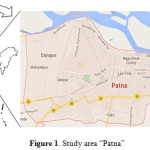 |
|
Methodology
A reviewfor municipal solid waste management of India reported physical characteristics of municipal solid waste for many metrocities12. So, the physical characteristics of solid waste for Patna city were taken from12. The typical percentage of moisture content, density and energy content for each component were used to calculate the same for MSW in this study (Ali et al., 1999). Chemical composition was estimated for MSW using typical values of MSW component13. Chemical characterization was done for carbon, hydrogen, oxygen, nitrogen and sulfur for each component of MSW then the same was calculated for MSW. Afterwards, mass was calculated for chemical composition and chemical formulation was made using molar weight.
Results and Discussion
Moisture content (%), dry mass (kg), volume and total energy for MSW have been calculatedin Table 1. The overall moisture content and density for MSW is35.43% and 204 kg/m3. The energy content as discarded solid waste is 8.4 MJ/kg while energy content for dry ash and ash free dry ash are 13 and 14.1 MJ/kg. Here, 5% ash content was assumed.
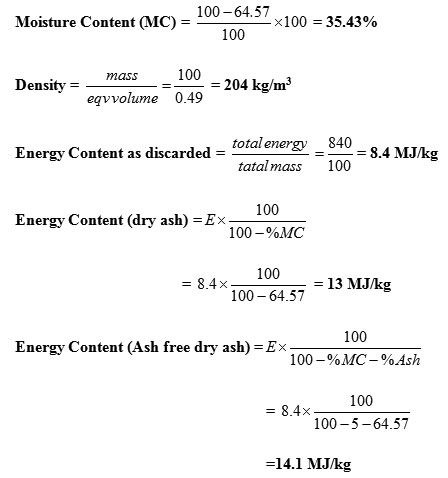
The total MSW generation in Patna city is 511 tons/day and the total dry mass of MSW is 330 tons/day. The total energy content (Dry Ash) is 4.3×106 MJ/day while energy content (Ash free Dry Ash) is 4.4×106 MJ/day. The chemical composition of MSW has been shown in Table 2 and Table 3.
Table 1: Physical characteristics of solid waste for Patna city (By weight)
|
Name of Component |
% of Composition |
Moisture Content % |
Dry Mass (kg) |
Density (kg/m3) |
Volume (m3) |
Energy (MJ/kg) |
Total Energy (MJ) |
|
Paper |
4 |
6 |
3.76 |
85 |
0.047 |
16.75 |
67 |
|
Textile |
5 |
10 |
4.5 |
65 |
0.078 |
17..45 |
87.25 |
|
Leather |
2 |
10 |
9.8 |
160 |
0.031 |
17.45 |
34.9 |
|
Plastic |
6 |
2 |
5.88 |
65 |
0.092 |
32.60 |
195.6 |
|
Metal |
1 |
3 |
0.97 |
320 |
0.003 |
0.70 |
0.7 |
|
Glass |
2 |
2 |
1.96 |
198 |
0.010 |
0.15 |
0.3 |
|
Ash, fine other |
35 |
8 |
32.2 |
480 |
0.073 |
7 |
245 |
|
Compostable |
45 |
70 |
13.5 |
290 |
0.155 |
4.65 |
209.25 |
|
Total |
100 |
|
64.57 |
|
0.49 |
|
840 |
The oxygen requirement for MWS is 1.9×105 kg O2/day or 1.33×108 L of O2 /day to degrade MSW. The present MSW of Patna city can generate methane gas (CH4) 2.46×105 kg/day 3.44×108 L/day and carbon dioxide (CO2) 5×105 kg/day or 2.55×108 L/day. The recovery from solid waste can be utilized to proper landfilling of MSW.
Table 2: Chemical Characteristics of Solid Waste
|
Component |
Wet mass (Kg) |
Dry mass (kg) |
C |
H |
O |
N |
S |
Ash |
|
Paper |
4 |
3.76 |
1.64 |
0.864 |
5.076 |
0.351 |
0.054 |
0.675 |
|
Textile |
5 |
4.5 |
2.475 |
0.23 |
1.65 |
0.0112 |
0.007 |
0.23 |
|
Leather |
2 |
9.8 |
1.08 |
0.03 |
1.404 |
0.207 |
0.007 |
0.112 |
|
Plastic |
6 |
5.88 |
3.53 |
0.144 |
0.208 |
0.18 |
0.007 |
0.18 |
|
Metal |
1 |
0.97 |
- |
0.42 |
1.34 |
- |
- |
0.59 |
|
Glass |
2 |
1.96 |
- |
- |
- |
- |
- |
- |
|
Ash, fine other |
35 |
32.2 |
8.47 |
- |
- |
- |
- |
- |
|
Compostable |
45 |
13.5 |
6.48 |
0.97 |
0.64 |
0.161 |
0.06 |
21.896 |
|
Total |
100 |
64.57 |
23.68 |
2.76 |
10.32 |
0.910 |
0.13 |
23.68 |
Table 3: Ultimate Analysis of Combustible Components
|
Component |
Mass (kg) |
Kg/mole |
Mole |
Ratio w.r.t. S |
Ratio w.r.t. N |
|
C |
23.68 |
12 |
1.97 |
492.5 |
28.14 |
|
H |
2.67 |
1 |
2.67 |
667.5 |
38.14 |
|
O |
10.32 |
16 |
0.645 |
161.25 |
9.14 |
|
N |
0.91 |
14 |
0.07 |
17.5 |
1 |
|
S |
0.41 |
32 |
0.004 |
1 |
Chemical Formula MSWis given below in equation (1) and (2).
C492.5H667.5O161.25N17.5S ...(1)
C28.14H38.14O9.14N17.5 ...(2)
Molecular weight = 536.06 kg
Oxygen required for complete aerobic stabilization
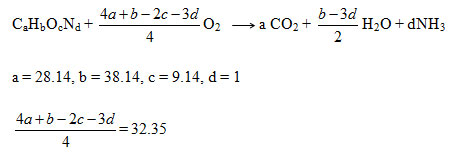
Since 536.06 kg solid waste requires 32.35×32 kg O2

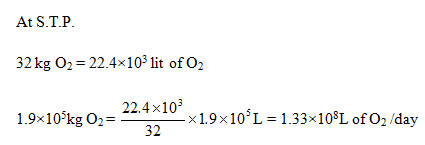
Recovery of Methane Gas



Recovery of Carbon Dioxide Gas
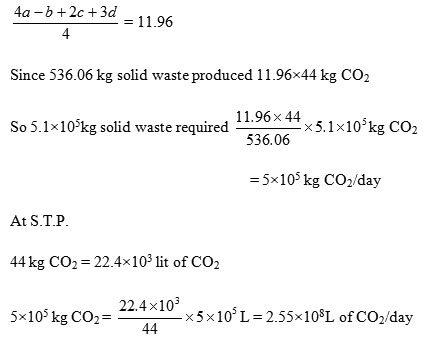
Conclusions
In India and many other developing countries, the segregation, collection, transportation and disposal of municipal solid waste (MSW) are generally done in a very unscientific way presently. This leads problems for environment in terms of water, air and odour pollution. This paper presented a study for solid waste management for an urban city Patna of India. The components of MSW have been estimated and based on that, 35.43% moisture, 204 kg/m3density and 14.1 MJ/kg (dry ash) energy content have been quantified. Afterwards, chemical compositions have been calculated and chemical formula has been made as C28.14H38.14O9.14N17.5 for MSW. This composition can help to estimate 1.33×108 L of O2/day requirement of oxygen to degrade MSW and recovery of 3.44×108 L of methane/day and 2.55×108 L of carbon dioxide/day from MSW.
Generally, landfill for solid waste management is planned for fifteen years or more than that. It is carried out in several parts or layers which take many years. The calculation of energy content, requirement of oxygen to degrade MSW and recovery of methane, carbon dioxide from MSW have been carried out for a year which can be extended for whole landfill period.
References
- M. K. Ghose, a K. Dikshit, and S. K. Sharma, “A GIS based transportation model for solid waste disposal-a case study on Asansol municipality,” Waste Manag., vol. 26, no. 11, pp. 1287–1293, 2006.
CrossRef - K. Kumari, N. Ranjan, and R. C. Sinha, “Solid waste management in Patna – analyses of ambient air and ground water pollution,” Int. J. Environ. Technol. Manag., vol. 14, pp. 310–325, 2011.
CrossRef - S. Kumar, J. K. Bhattacharyya, A. N. Vaidya, T. Chakrabarti, S. Devotta, and A. B. Akolkar, “Assessment of the status of municipal solid waste management in metro cities, state capitals, class I cities, and class II towns in India: An insight,” Waste Manag., vol. 29, no. 2, pp. 883–895, 2009.
CrossRef - T. Narayana, “Municipal solid waste management in India: From waste disposal to recovery of resources?,” Waste Manag., vol. 29, no. 3, pp. 1163–1166, 2009.
CrossRef - N. Gupta, K. K. Yadav, and V. Kumar, “A review on current status of municipal solid waste management in India,” J. Environ. Sci., vol. 37, pp. 206–217, 2015.
CrossRef - S. Rathi, “Alternative approaches for better municipal solid waste management in Mumbai, India,” Waste Manag., vol. 26, no. 10, pp. 1192–1200, 2006.
CrossRef - M. Sharholy, K. Ahmad, G. Mahmood, and R. C. Trivedi, “Municipal solid waste management in Indian cities – A review,” Waste Manag., vol. 28, no. 2, pp. 459–467, 2008.
CrossRef - S. Gupta, K. Mohan, R. Prasad, S. Gupta, and A. Kansal, “Solid waste management in India: Options and opportunities,” Resour. Conserv. Recycl., vol. 24, no. 2, pp. 137–154, 1998.
CrossRef - P. K. Srivastava, K. Kulshreshtha, C. S. Mohanty, P. Pushpangadan, and A. Singh, “Stakeholder-based SWOT analysis for successful municipal solid waste management in Lucknow, India,” Waste Manag., vol. 25, no. 5, pp. 531–537, 2005.
CrossRef - K. Kumari, S. R. Singh, and R. C. Sinha, “Role of pollution control boards in municipal solid waste management Kanchan Kumari,” Int. J. Environ. Technol. Manag., vol. 17, pp. 100–112, 2014.
CrossRef - CPCB, “Management of Municipal Solid Waste,” Pollut. Control Board (Ministry Environemntal For., p. Government of India, 2000.
- M. Sharholy, K.Ahmad, G. Mahmood and R. C.Trivedi, "Municipal solid waste management in Indian cities – A review". Waste Manag. 28, 459–467, 2008. doi:10.1016/j.wasman.2007.02.008
CrossRef - S.M. Ali, A.P. Cotton, and K. Westlake,. "Down to Earth: Solid Waste Disposal for Low-Income Countries", WEDC, Loughborough University, UK (1999).
- G. Tchobanoglous, H. Theisen, and R. Eliassan, “Solid WastesEngineering Principles and Management Issues”, McGraw-Hill Book Company, New York, (1999).







